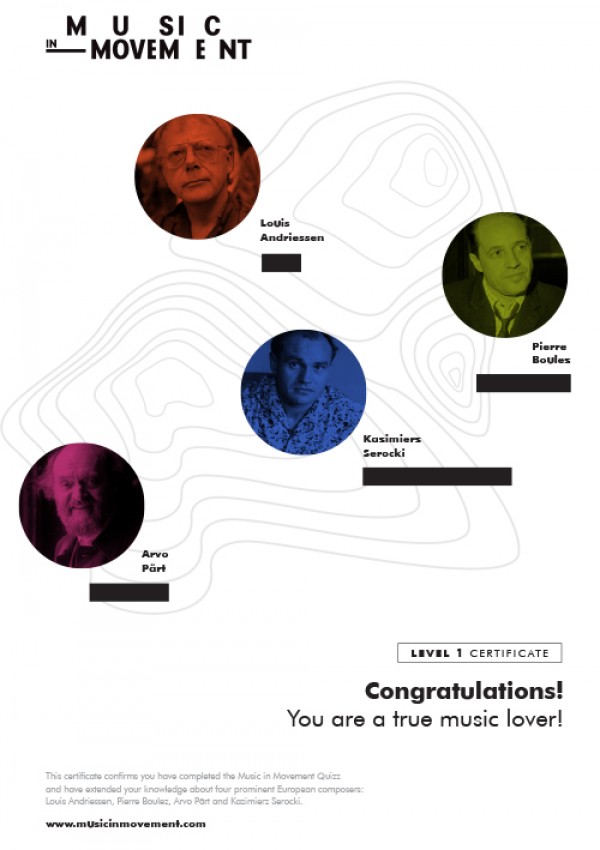MiM quiz – Expert level / Education
Remember, this quiz is not about testing your knowledge about contemporary music. It's all about getting to know the four composers - their music, techniques, but also inspirations and private stories. We invite you to take on this challenge - discover the universe of four personalities and dive in into their music.
Composers and trends of music of the recent and distant past had a considerable influence on all four composers. Link a source of inspiration to a composer.
The affinity between Stravinsky’s and Louis Andriessen’s music is evidenced not only by the Dutch composer’s works but also by a book devoted to the Russian’s oeuvre which Louis Andriessen co-authored (The Apollonian Clockwork).
The impact of Bartók’s music can easily be discerned in Kazimierz Serocki’s oeuvre of the first half of the 1950s, for example, in his Sonata for piano.
To a large extent the style and techniques Arvo Pärt developed in the late 1960s and early 1970s were a result of his studies of Renaissance and late medieval polyphony, and Gregorian chant.
The avant-garde of the 1950s, including Pierre Boulez, considered the music of Anton Webern to be its predecessor and model to be developed further.
Creative periods - Pierre Boulez
Which work by the composer is earlier? Which is later?
The earlier one should be indicated.
Discreet use of live electronics (delay, reverb diversification) points to a later period of Pierre Boulez creations, associated with the IRCAM technology (Dialogue de l'ombre double, 1985). In the case of Le marteau sans maître (1954), the earlier date is indicated, inter alia, by the melody characteristic for the avant-garde of the 50s.
Which ones among the four composers created such ensembles?
Many contemporary composers were also performers of their own (and not only their own) music; some even founded ensembles specialising in performances of contemporary works (not only their own).
In 1976 Pierre Boulez founded Ensemble Intercontemporain – an ensemble of 31 soloists specializing in new music, which became a model for similar enterprises in France and other countries. Louis Andriessen sought to create a new type of ensembles, providing an alternative to the line-ups and modes of operation of conventional orchestras and chamber ensembles – he put his concepts into practice in Orkest de Volharding and Hoketus, which he co-founded.
20th- and 21st-century composers would often explain their composition techniques and engage in more general theoretical reflections
Many published books or articles; some conducted lectures at universities or courses, sometimes also commented on their works during encounters with non-expert audiences. But there were also those who did not comment on their oeuvres, assuming that music spoke for itself.
He published many books on music written by himself and other composers (especially 20th-century composers). In addition to educational and theoretical work addressed to specialists (composers, musicians, theorists), he devoted a lot of attention to providing comments on contemporary works for concertgoers, including young people.
He lectured in composition at conservatories and courses for young composers. He wrote one book – but he did not devote it to his own oeuvre but to the music of a composer that was artistically particularly close to him.
He did not give interviews and was reluctant to comment on his own oeuvre. He included his reflections on the foundations of his music in several hitherto unpublished lectures.
He did not write about his own music, but in interviews and numerous contributions on various occasions he said a lot about it.
Well done!
We hope you enjoyed the experience!
You can now share & save your MiM certificate!

